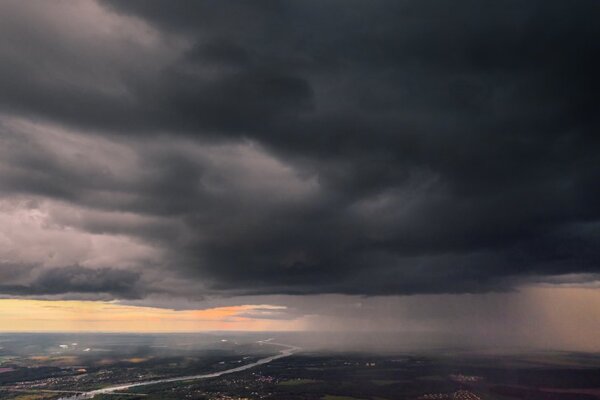Belt and braces: Are we flying into a turbulent era for travel?
 Gary Noakes
Gary NoakesRecent incidents of severe turbulence will no doubt have unsettled nervous flyers – but are these events really becoming more common? What’s causing them? What is the industry doing to keep passengers safe? And what can agents say to their clients? Gary Noakes reports.
The view from the window at 36,000 feet is usually calm and clear – serene even. But without warning, all hell can break loose.
Clear air turbulence (CAT), as the name suggests, is difficult to predict and, as recent incidents have shown, can be very dangerous for passengers.
The latest, an Air Europa flight from Spain to Uruguay earlier this month, injured 30 in just three seconds and forced an emergency landing in Brazil.
Last December, a P&O Cruises charter flight – operated by Maleth Aero – encountered "freak" turbulence, injuring 11 and requiring a diversion to Bermuda.
In May, nearly 50 people were serious injured onboard Singapore Airlines flight SQ321, which hit turbulence over Myanmar en route from Heathrow. One UK national suffered a fatal heart attack.
This was extreme, but nervous fliers will have noted that just six days later, 12 people were injured in another turbulence incident onboard a Qatar Airways flight to Dublin as it flew over Turkey.
All these incidents involved UK and Irish passengers, meaning they made headlines here.
Understandably, there will be many nervous fliers who will now be looking ahead to their summer holiday with trepidation.
So what do you say to these anxious clients?
Real-time data ‘paramount’
The first and most obvious response is that while any turbulence can be dangerous, none of it presents a threat if passengers are strapped in – not that they have to be unless the seatbelt signs are illuminated.
All the injuries caused in these incidents were to crew or passengers not buckled up. In the Air Europa incident, 315 passengers escaped physical harm.
Admittedly, there is scientific evidence to conclude these incidents are becoming more common. In June 2023, University of Reading scientists said there was "clear evidence of large CAT increases in various places around the world".
The team’s research used 21 different calculations. "We find, for example, that at a typical point over the North Atlantic, the upward trend is such that the strongest category of CAT was 55% more frequent in 2020 than in 1979," they said, adding the findings were "consistent with the expected effects of climate change".
However, nervous flyers can though rest assured most turbulence is predictable and nowhere near as severe as the incidents that make the headlines.
Extreme incidences remain rare given the millions of flown hours; figures from Airbus show that between 2014 and 2018, there were around 60 a year globally, on average, with injuries recorded on only 12% of affected short-haul flights and 30% of affected long-haul flights.
Meteorological forecasts and aircraft weather radar allow pilots to skirt around thunderclouds, by far the most common cause of bumpy flying. However, neither are adept at spotting the danger in clear air, with radar unable to see CAT because there are no water droplets.
Consequently, most pilots rely on communication between flights as a warning, particularly in hotspots like the Bay of Bengal, with Iata admitting: “Currently there is limited real-time information regarding precise locations and intensity of turbulence.”
That is changing with Iata’s new Turbulence Aware programme. It allows aircraft-generated data to be collated in real-time and relayed to other airlines not normally sharing information.
Emirates, ANA and WestJet are the latest to join, with Emirates having equipped more than 140 aircraft with the necessary software, so those airlines signed up to Turbulence Aware may offer nervous passengers some reassurance.
Swiss International Air Lines is one. Thomas Weber, head of flight dispatch, said: “Here in Switzerland, with the mountains, you always have turbulence from time to time. Having real-time data is paramount. The big change is we now know that if we get an alert from altitude, it’s what’s going on at that moment in the airspace.”
Aircraft built for the job
Nervous flyers can also be assured it is a myth aircraft fall thousands of feet during severe episodes. In a brief, but undoubtedly terrifying, five-second period, the Boeing 777 operating Singapore Airlines flight SQ321 fell 178 feet.
Initial reporting of the casualties said the aircraft had “descended 6,000 feet in three minutes”, adding to the horror. In fact, the pilots made a controlled descent from 37,000 feet, likely to where the air was smoother. While there is no way to diminish what the passengers went through, it was not as drastic as first reported.
Then there are understandable fears about structural damage to aircraft. Engineers agree that very, very few flights have been lost due to turbulence and that modern airliner design means it is all but physically impossible, as flight SQ321 proved.
It is generally concluded the only real modern day loss owing to turbulence was in 1966 when a BOAC Boeing 707 broke up near Japan’s Mount Fiji. It encountered CAT that stressed the aircraft beyond design limits – limits that are much tougher for today’s airliners.
The most recent example was in 2001 when an American Airlines flight departed New York JFK for the Dominican Republic and encountered the wake of another flight.
Pilot error resulted in incorrect usage of the aircraft’s rudder, which over-stressed the tail and caused a disaster. The way the situation was mishandled became standard avoidance training for pilots.
Time for regulation?
The industry is pondering how to react following the Air Europa and Singapore Airlines incidents. So far, no carrier has upgraded the standard advice that passengers should keep their seatbelt “loosely fastened” throughout the journey.
Bar UK, which represents UK carriers, is doubtful this will change, with a spokesperson questioning whether it would even be feasible to mandate it and then enforce it.
Iata has not issued any edicts. Nick Careen, Iata senior vice-president for operations, safety and security, said: “Airlines are not planning to require passengers to keep seatbelts on at all times. However, airlines have long recommended passengers fasten their seatbelts when seated.”
However, Nick Butcher, a consultant with aeronautical and safety engineers R.G.W. Cherry, takes a different view. “I believe regulators need to review mandatory requirements and operators need to review their procedures,” he told TTG.
“In Australia, the seat belt ON sign now applies to all occupants, including cabin crew. I think Australia is one of the few countries with this requirement.”
That could change; aside from the injuries and public relations implications for airlines, there is the financial cost to consider. The most severely hurt from the Singapore Airlines incident will receive an initial $25,000, with those with minor injuries getting $10,000 and all 211 passengers receiving a full fare refund. Everyone onboard will doubtless also be approached by law firms keen to increase these amounts.
Butcher believes this could be the thing that forces airlines to change what they tell passengers over the public address system. He concluded: "Litigation might be a driver, especially if it’s true that global warming might increase the level of such events."
Sign up for weekday travel news and analysis straight to your inbox

Gary Noakes
Supplier Directory
Find contacts for 260+ travel suppliers. Type name, company or destination.



















